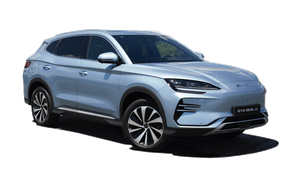What it meant at the time was that Citroën’s fleet department could also enter the large electric van market, where Fiat offered a more efficient and far less expensive alternative to the only other big electric van on sale at the time – the Mercedes e-Sprinter. Its appeal was limited, not least because of dreadfully slow performance and a rather rudimentary finish.
While all this was going on, FCA was developing an electric version of the Fiat Ducato in-house, and as the Fiat shared its architecture with the Relay and Boxer – a hangover from a joint venture between Fiat and PSA (Peugeot and Citroën) in the early 2000s – it was easy enough to use the same powertrain in a Citroën van as well. Coincidental, yet also convenient, as it meant that before even a whiff of a merger was in the air, there was an off-the-peg big electric van good to go.
Cue the e-Relay 2 – a Ducato in disguise, but with a 75mph top speed, a similar 143-mile range and a better fit and finish. Still with us? Great, because the story hasn’t finished yet.
Fast forward to 2024 and along came e-Relay 3 – the third generation in as many years. It used the same large panel van body, and this time was identical in all but badges and minor details to the Peugeot e-Boxer and Fiat Ducato, as well as the RAM Promaster EV in the USA and the Vauxhall Movano Electric, which had an even more confusing gestation as it had to get divorced from the Renault Master before embracing its new Stellantis identity.
A sea of new model names abounded, but from the windscreen backwards nothing changed – it was still the same goofy-nosed, jumbo-sized panel van it had been since the mid-2000s, dragged kicking and screaming into the EV age.
This time, though, things got a bit more serious thanks to a battery pack and motor developed by Stellantis Group to be integrated into the chassis, using the same mechanical components as the previous e-Relay but with a vastly extended range – now up to 261 miles on the WLTP cycle.
It's powered by an electric motor producing 270bhp (more than double its predecessor) and 400Nm of torque, with a monster of a 110kWh battery and a standard three-phase 11kW onboard charger.
Stellantis also made a song and dance about the new digital cabin – something that the original van’s designers couldn’t have foreseen in 2006, but which is probably its only stand-out feature today.
Range, Battery and Charging
Just the one battery is offered, but it’s a bit of a monster– a 110kWh unit feeding a 272PS electric motor.
The Citroën e-Relay claims a WLTP-derived range of 261 miles, which is pretty impressive for a large electric van and will boost its appeal to those who may not previously have considered electric propulsion in this area of the market.
Using a 150kW fast charger, it’ll boost from 10-80% in around 55 minutes, which is far from shabby given the size of the battery. An 11kW three-phase onboard charger helps with home charging, too, but you’re still looking at 12 hours from a 7.5kW wall box, so it makes sense to plug-in as soon as you get home from work.
Practicality, Payload and Dimensions
Outside, the latest e-Relay has a new, more aerodynamic front bumper, redesigned rear-view mirrors for better airflow and a body-coloured grille, along with full LED front headlights.
Just one wheelbase is available at 4.04m, but it’s offered with a choice of body lengths. A chassis cab version is also on offer for converters and camper van derivatives, the latter of which has long been a core market for Citroën with its larger vans.
As a result of its much beefier battery and more potent electric motor, there’s a useful increase in payload up to 1,500kg. That still lags behind the 2.2-litre diesel model, but it gives much more flexibility to large van users and is on a par with the Ford eTransit and Mercedes-Benz e-Sprinter.
In panel van form, it’s offered in two lengths and two roof heights, all of which are pretty big. In long-body high-roof format, it has a total cargo volume of 17 cubic metres, while load lengths range from 2.58 metres in medium double cab layout to 4.07m in L3 panel van guise.
All versions have twin side doors, LED lighting, multiple lashing points and doors that open to 270 degrees, with ply-lining and a rubberised load floor offered as options.
Interior, Seating and Technology
Here’s some food for thought – when the Citroën Relay first appeared with this body in 2006, the first-ever iPhone was still 14 months away and MySpace was the world’s biggest social network, with Mark Zuckerberg’s ‘The Facebook’ (as it was then known) a young upstart.
Its designers could never have foreseen a third generation of the same van with wireless induction charging and a large central touchscreen, featuring Apple CarPlay and Android Auto compatibility – but here we are.
Indeed, the cabin is by far the most sophisticated part of the e-Relay. As well as a new multifunction steering wheel, dashboard, fabrics, and door panels, thoughtful touches include an optional 230V socket in the centre of the dashboard for powering electrical devices such as laptops, batteries and tablets up to 150w.
The instruments of the old model give way to a state-of-the-art digital display showing speed, range and battery percentage, while the standard 3D Connected Navigation and all major infotainment and climate control settings are operated via the 10-inch touchscreen. In addition, an optional mains socket in the dash can be used to give power to smaller items such as laptops and battery chargers. We like the accessibility of the volume and heater controls, too, which are simple and intuitive – essential for a vehicle that might have multiple users.
It's a markedly smarter cabin than in the previous Citroën e-Relay and is a comfortable, spacious and well-equipped large van.
Motors, Performance and Handling
The e-Relay comes with three driving modes: “Normal” (limited to 160 kW power output), “Eco” for range optimisation (120 kW) and “Power” for full performance (200 kW).
Whichever mode you’re in, the kick-down function of the throttle will automatically select Power if you’re joining a motorway or dual carriageway from a slip road or overtaking, for example, so the third setting is rarely needed and we wonder why it’s even there at all.
Also new are four different levels of regenerative braking, selectable using steering wheel paddles. The most substantial of these – B – will slow the van to a walking pace and comes into its own in heavy stop-start traffic, increasing overall range.
The technology fails to disguise the van’s age, though. It features double leaf springs at the rear that transmit bumps and jolts into the cabin, especially when unladen, and the steering is completely devoid of feel. It’s not a difficult van to drive around town, but on the open road it feels ponderous and nowhere near as composed as the latest Renault Master E-Tech or Mercedes-Benz e-Sprinter, or even the cheaper Maxus e Deliver 9.
There are multiple safety assistance systems to help out, though, including traffic sign recognition, forward collision alert with emergency braking and side blind-spot alert, drowsiness alert, lane keeping assist, adaptive cruise control, 360-degree parking sensors, parking assist and Stellantis’s ‘Dynamic Surround View’ digital rear view mirror, which projects camera images from the rear of the van directly to the driver’s eyeline.
It’s clever stuff, but more useful in dynamic driving rather than for parking and manoeuvring, where the lens curvature of the cameras makes distances difficult to judge.
Running costs, Pricing and Specs
Only one trim level is offered – Enterprise – and it’s well-equipped, with all of the standard equipment listed above. Prices start at £49,485 for the L2 shorter wheelbase model with standard roof, rising to £57,035 for the LWB high roof.
Depreciation is projected to be steeper than the e-Sprinter and Master, although residual values have yet to be confirmed. However, it may well make more sense as a used van than it does new.
For the latest monthly offers on this or any other van, with free fast delivery, call our partner Vanaways on 0800 368 3286
Verdict
Make no mistake – the latest iteration of the Citroën Relay is immeasurably better than the original. But while the technological advancements in the cabin are both welcome and significant, it falls short in many ways, as a result of the age of the basic van on which it is based. This is the third incarnation of a vehicle that was launched in 2006, and the harsh ride when unladen, vague steering and ponderous high-speed handling mean that the dynamic package can’t match the technological features on offer.
If you want a hugely spacious electric van that’s good value and has a decent range, that might not bother you – but there are no innovations here.
























